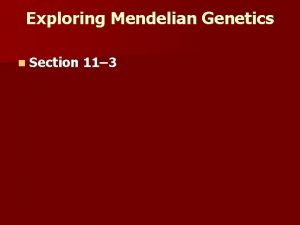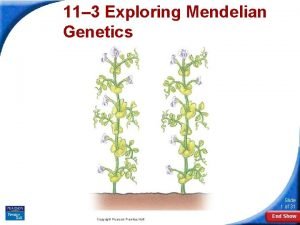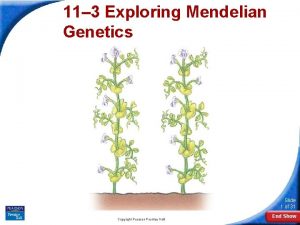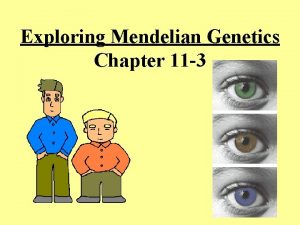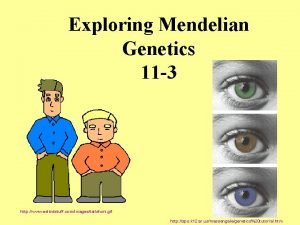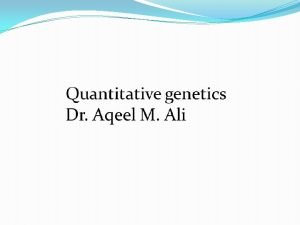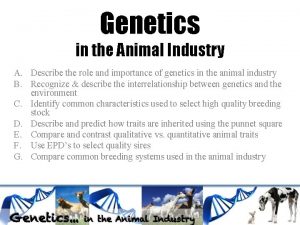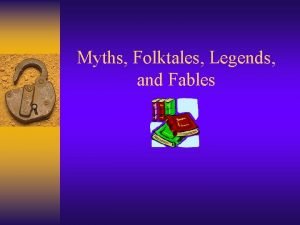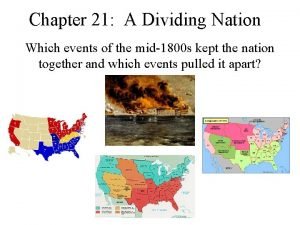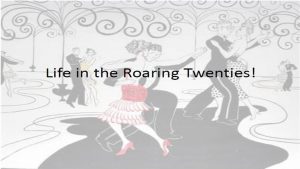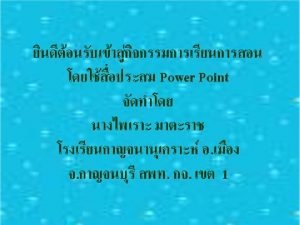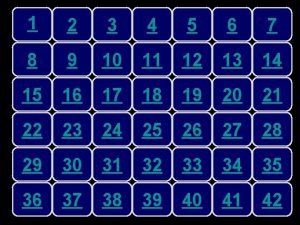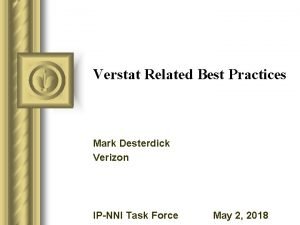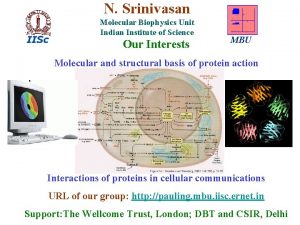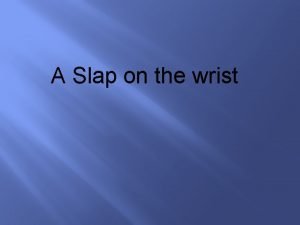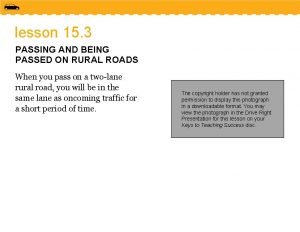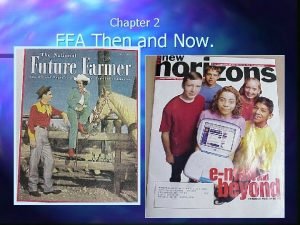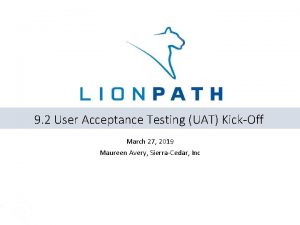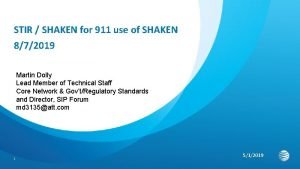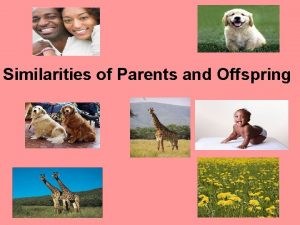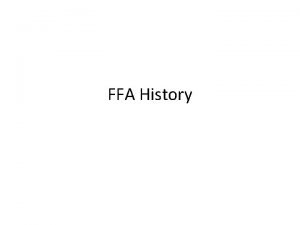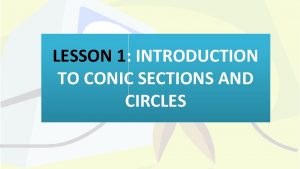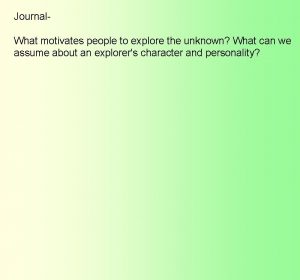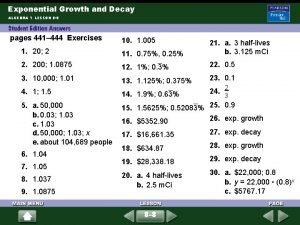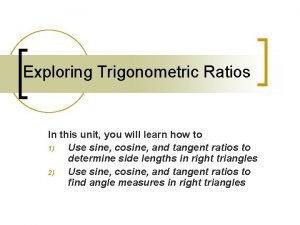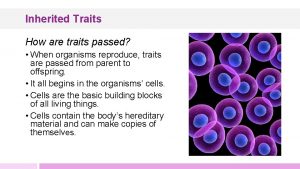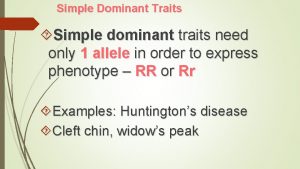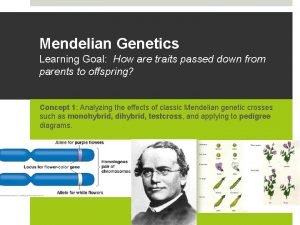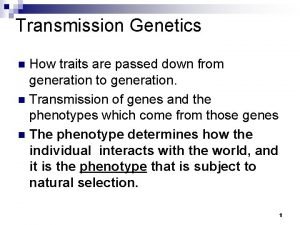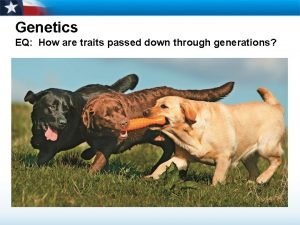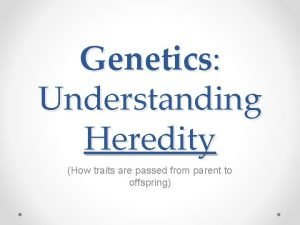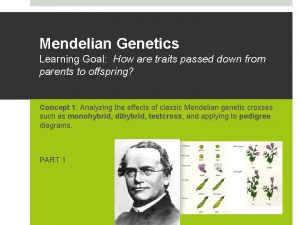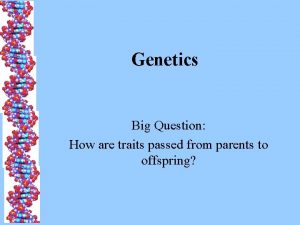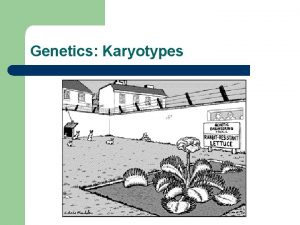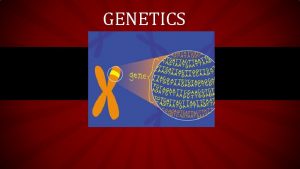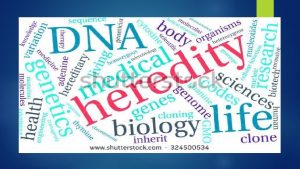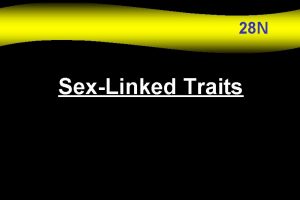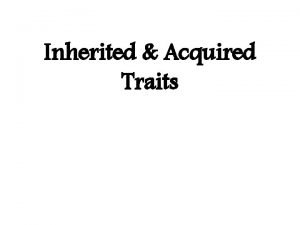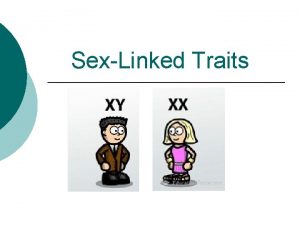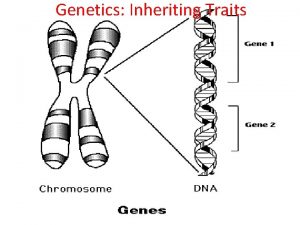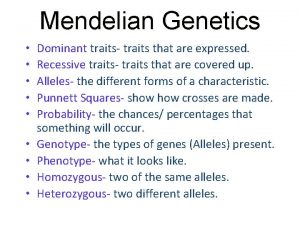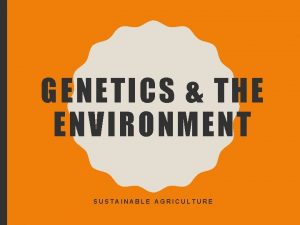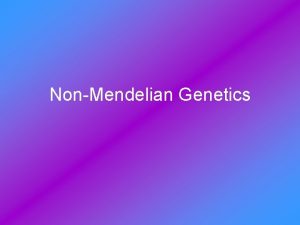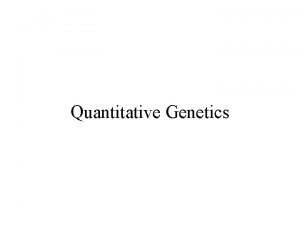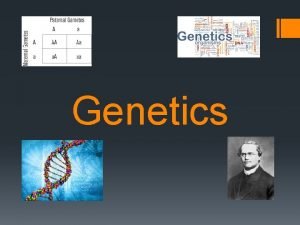Simple Genetics Exploring How Traits are Passed On


























































- Slides: 58

Simple Genetics Exploring How Traits are Passed On

Punnett Squares � In order to determine the traits that a person might inherit, we use a simple diagram called a Punnett Square! � Punnett Squares give us the probability of an offspring having particular traits

Pieces of the Puzzle � Before completing a square, you must know the components � Allele-a variant form of a gene � Humans inherit one allele from each parent that determines a trait � For example, alleles might determine if you have curly or straight hair, are tall or short, etc. � Dominant-A dominant allele show their effect even if there is only one copy of the allele (think of them as being strong!) � Dominate alleles are denoted by a capital letter (ex. A) � Recessive- A recessive allele will only show up if no dominant alleles are in place (think of them as being weak!) � Recessive � Dominant alleles are denoted by a lowercase letter (ex. a) and Recessive alleles pair together to

Homozygous vs. Heterozygous � So…alleles pair together (AA, aa, Aa) � Homozygous-if both letters are identical (both dominant (capital) or both recessive (lowercase)), the alleles are homozygous “Homo” means “same” � Ex. Let’s say “A” represents the allele for a widow’s peak, and “a” represents the allele for a straight hairline � �A person with “AA” would be called homozygous dominant � A person with “aa” would be called homozygous recessive � Heterozygous-if both letters are different (one dominant (capital) and one recessive (lowercase)), the alleles are heterozygous � “Hetero” means “different” �A person with “Aa” would be heterozygous � Would they have a widow’s peak or a straight hairline?

Phenotype and Genotype � All of these allele combinations tell us the phenotype and genotype of a person � Genotype-The organism genetic, inheritable information of an � Example: A person’s genotype is Aa (heterozygous); they can pass on either a dominant allele or a recessive one to their children. � Phenotype-The organism � Example: outward, physical appearance of an A person has a widow’s peak

Let’s Practice � Dominant or Recessive? �A �b �B � Heterozygous or Homozygous? � AA � Bb � cc � Phenotype � She or Genotype? is homozygous recessive (rr) � She has blue eyes

Building a Punnett Square � Consider the following alleles for � AA (Yellow-homozygous dominant) � Aa (Yellow-heterozygous) � aa (Green-homozygous recessive) � Let’s pea plant color: say you had two pea plants, both heterozygous yellow (Aa), and you wanted to know what color plants would be produced. How would you find out? � Set up and Punnett Square

Building a Punnett Square � What we know: Both parent plants are Aa � So, cross Aa x Aa will be carried out in the Punnett Square below: Mother Father *Note: It doesn’t matter where you set up the mother/father, the results will be the same!

Building a Punnett Square � So, how do you carry out a Punnett Square? � Father’s letters cross to the right � Mother’s alleles cross down, filling in the squares to Mother complete the allele AA Aa Father Aa aa *Notice each potential combination has one allele from mom and one from dad

Interpreting the Final Square � Once the square is finished, always determine the genotype and phenotype ratios of the possible offspring Genotype: 1: 2: 1 -1 AA, 2 Aa, and 1 aa Phenotype: 3: 1 -3 Yellow, 1 Green Note: These ratios are equally probable for each offspring, meaning each offspring has the same chance of inheriting the traits!!

Practice � Complete the Cross: Tt x tt Genotype: Phenotype:

Practice W= long whiskers (dominant) w=short whiskers (recessive) � What is the probability of producing offspring that have short whiskers from a cross of two long whiskered seals, one homozygous dominant and one heterozygous? Genotype: Phenotype:

A Few Notes on Genetics… � Some traits are controlled by more than one pair of genes, and so present a wide range of phenotypes – called POLYGENIC traits (ex. Skin, hair, eye color) � All traits depend on both genetic and environmental factors � Heredity determines your traits, but the environment may play a role in how they act

Genetic Diseases How Diseases are Carried Through Generations

Dominant and Recessive � If a disease is recessive, both parents have to pass on a mutated allele to the offspring � Those who are heterozygous (Aa) are carriers, meaning they have the mutated allele and can pass it on, but are healthy themselves � If a disease is dominant, only one parent has to pass on the mutated allele for offspring to have it � Can a person with a dominant disease be a carrier?

Let’s take a look at some specific genetic diseases…

Cystic Fibrosis (cf)-Recessive � This disease causes a mucus buildup in the lungs and digestive system � Those affected have difficulty breathing and poor growth � Common in those with European Ancestry � Live expectancy up to 35 years thanks to gene therapy

Sickle Cell Anemia-Recessive � This disease affects a person’s red blood cells � A mutation causes the cells to be long and bent (“sickle” shaped) � The odd shape causes the cells to get stuck in blood vessels � Cuts off blood flow and circulation � Common in those with African ancestry � Carriers are associated with malaria resistance-we’ll discuss why later!

PKU-Recessive � PKU- Phenylketonuria � A condition in which the body is missing the enzyme that breaks down phenylalanine, an amino acid � This means it builds up in the body, which results in mental deterioration � Memory loss/identity loss! � People affected have to keep a low protein diet and have the enzyme injected regularly � This must be done for life!

Huntington’s-Dominant � This disease affects the muscles of the body � Those affected will slowly have muscle function decline � Painful, like a muscle cramp that won’t go away � Unfortunately, it often does not show signs until the person reaches mid 30 s-can take up to 20 years to kill! � Shows up after the person has already had children, meaning that they have already passed the allele � Affects all people!

Genetic Disease Punnett Squares �A woman who is a carrier for Cystic Fibrosis marries a man who is also a carrier. What is the probability that they will have a child with Cystic Fibrosis?

Genetic Disease Punnett Squares �A woman is concerned that she may develop Huntington’s Disease because her father has it. What is the probability that she has Huntington’s? Note: The woman’s mother does not have Huntington’s Disease.

Punnett Square Practice � **FRONT AND BACK!** � 1 st and 3 rd: page 36 � 2 nd: page 38 � On the front, do the Punnett square practice problems � On the back, do the Punnett Square Practice Vocab � When you finish, you may work on your 2 nd section of your vocab project!

Complex Genetics Codominance, Incomplete Dominance, Sex-Linked Traits, and Blood Typing

Incomplete Dominance � Sometimes, one allele is not completely dominant over another allele � In this case, the offspring are blends of both parents! � The heterozygote has a unique phenotype because one gene does not dominate the other � Example: Red Flower (RR) + White Flower (WW)= Pink Flowers (RW)

Incomplete Dominance � During incomplete dominance, organisms who are heterozygous for a trait have the opportunity to pass either gene to the offspring � Therefore, a cross between two heterozygous organisms have the following results: 1 RR: 2 Rr: 1 rr 1 Red: 2 Pink: 1 White

Incomplete Dominance Example �A red carnation is crossed with a white carnation and the resulting offspring are all pink (indicating incomplete dominance). What would be the result of a cross between a pink and a white carnation?

Codominance � Sometimes, � Therefore, both alleles are equally dominant both alleles will be expressed in phenotype � In this case, the offspring display the traits of both parents! � Example: White Cow (WW) + Brown Cow (BB)= White and Brown Cow (BW) (AKA Roan Cow)

Case Study: Sickle Cell Anemia � Although we discussed Sickle-Cell Anemia’s recessive inheritance pattern, the disease does display a certain codominance � Those homozygous affected (aa) have misshapen cells � Those homozygous unaffected (AA) have normal cells � Those heterozygous (Aa) are unaffected carriers, but can have some misshapen cells mixed in � This unique feature means heterozygous individuals are resistant to severe malaria!

Codominance Example �A bird with white and blue feathers mates with another white and blue bird (BW). What are the phenotypic ratios of the offspring?

Blood-Typing � Human blood types include a codominance pattern � Humans can have type A, B, AB, or O blood � The alleles involved are two codominant alleles (IA and IB), and one recessive allele (i) Genotype Blood Type IAIA or IAi A IBIB or IBi B IAIB AB ii O

Blood Type Practice Problem � The father is type A homozygous, and the mother is type O. What are the possible blood types of their children?

Is Parentage Possible? � Ralph has type B blood and his wife Rachel has type A blood. They are very shocked to hear that their baby has type O blood, and think that a switch might have been made at the hospital. Can this baby be theirs? Explain.

Sex-Linked Traits �Genes located on the sex chromosomes are called sex-linked genes �Usually found on the X Chromosome �Because of this, males are much more likely to express a trait than females, because males only have one X chromosome!

Sex-Linked Traits �Let’s take a look at the possible alleles in a recessive sex-linked disease: �Female: X NX N, X NX n, X n �Notice that the female must inherit 2 recessive copies to display the trait. It is also possible for females to be carriers of sex-linked traits. �Male: XNY, Xn. Y �Notice the male does not have a second X to help mask the trait. This means that if he inherits the recessive copy, he will display the trait! �Because of this, males are much more likely to inherit a sex-linked trait!!!

Common Sex-Linked Traits � Hemophilia-A bleeding disorder that slows the blood clotting process � Color-Blindness-The inability to see color, or perceive color differences � Because of its X-linked inheritance, both of these conditions are more common in men

Sex Linked Problems � Cross a woman carrier for hemophilia to a hemophiliac man. What percentage of the females could inherit the trait? Males?

Pedigrees Inheritance Patterns Through Generations

What is a Pedigree? �A pedigree is the recorded ancestry of a family � Pedigrees allow us to see the genotypes and inheritance patterns through the generations of a family

What Does a Pedigree Tell Us? �Pedigrees can give us insight into how traits are passed through families. You can tell a lot through a pedigree. For example: � The phenotypes and genotypes of individuals � The inheritance pattern. �If more males are affected, it is likely sex linked �If there are no carriers and one of the parents must have it, the disorder is dominant �If carrier parents produce some affected children, the disease must be recessive

Pedigree Example Problems � What type of inheritance pattern is shown below? � What would be the genotype of individual I-1?

Pedigree Example Problems � What type of inheritance pattern is shown below? � What would the genotypes be of individuals II-1 and III-5?

In guinea pigs, black coat color (B) is dominant to white coat color (b). What percentage of the offspring will be white when a homozygous black guinea pig is crossed with a homozygous white guinea pig? � a. � b. � c. � d. 0% 25% 50% 100%

Sickle cell anemia is a genetic disease caused by an autosomal recessive gene. If each parent carries one sickle cell allele, what are the chances that their child will have sickle cell anemia? a. no chance b. one in four c. two in four d. three in four

� When Mendel was experimenting with pea plant crosses, one of the traits that he examined was seed texture. The two phenotypes are smooth and wrinkled. The totals for his F 2 (small 2) generation was 5, 474 smooth and 1, 850 wrinkled, yielding a probability ratio of approximately a) 2: 1 b) 3: 1 c) 4: 1 d) 5: 1

�A scientist crossed roses (RR) with white roses (WW). The cross revealed a pattern of incomplete dominance in the heterozygous condition (RW). What percent of offspring of the cross were red roses? a) 0% b) 25% c) 50% d) 100%

� 26. A woman heterozygous for A blood marries a man heterozygous for B blood. What is the probability that they will produce offspring with AB blood? a) 0% b) 25% c) 75% d) 100%

The inheritance of short wings in Drosophilia fruit flies is an x-linked, recessive trait. Which would most likely result if a short winged female mates with a long winged male? a) All offspring would be short winged b) All females will be long winged, and all males will be short winged c) All females will be short winged, and all males will be long winged d) Half of the males and females will be short winged, and half will be long winged

� Color blindness is inherited as a sexlinked trait in humans. Use a Punnett Square to complete a cross of a colorblind male with a female with normal vision who is a carrier of the trait.

Bio. Facts 5. 1 4/19 W= long whiskers (dominant) w=short whiskers (recessive) � 1. What is the probability of producing offspring that have short whiskers from a cross of two seals, one homozygous recessive and one heterozygous? � 2. What is the probability of producing offspring that have short whiskers from a cross of two seals, one homozygous dominant and one heterozygous? � Draw the Punnett Square � Determine the Genotype ratios � Determine the Phenotype ratios � Answer the above question

Bio. Facts 2. 5 10/24 � Write the possible genotypes for the following blood types: � Type A: _____ or ______ � Type B: _____ or ______ � Type AB: _____ � Type O: _____ � Solve: There is a mixup between babies at the hospital. The baby has type O blood. On set of parents have the genotypes IAIA and IAi. The other set of parents are a heterozygous Type A mother and a heterozygous Type B father. Make the crosses of both sets of parents. Which set does the baby belong to?

Bonus questions for test… �Please write your answers on the first page of the test � 1. Who is the “father of genetics”? � 2. What blood type is the universal donor? � 3. What blood type is the universal acceptor?

Learning Log #5 Topics in Main Idea � What is independent assortment and how did you model this in the aardvark lab? � What is fertilization and how did you model this in the aardvark lab? � What does gene expression mean and how did you model this in the aardvark lab? � What is the difference between a dominant trait and a recessive trait? � What is the difference between homozygous and heterozygous? Give examples of each from the lab � What is the difference between a genotype and a phenotype? Give examples from the lab

Genetic Disease Research � Choose one genetic disease that we did NOT go over in the notes � Write a summary of that genetic disease and be sure to include the following: � Is it dominant / recessive / sex-linked � Who is affected most (men/women, ethnic groups) � Symptoms and diagnosis � Treatment options and life expectancy � At least FIVE interesting facts about the disorder � ALL sources used � When finished, turn in and work on vocab project

Copy on your notebook paper for Learning Log 5! �Learning Target: �I can define and model (1) independent assortment of chromosomes, (2) fertilization, and (3) expression of genes by creating a baby “aardvark. ” I can describe the pattern of inheritance (dominant vs. recessive) and the genotype (homozygous vs. heterozygous) and phenotype (physical appearance) of the baby “aardvark. ”

Creating your baby aardvark � Each person will receive a bag of genes in the form of ALLELES � Pair the alleles up and put them in order � Flip over the strips, shuffle them, and flip one over in front of your partner – then partner number 2 will do the same � This creates the first genotype of the baby aardvark! � Circle each genotype and phenotype and complete with all genes � Build your baby aardvark! � Use the genotype from the baby aardvark and find another baby – you will need to use Punnett squares to build the next baby!!!!

Clean Up Procedures (1 st & 2 nd) �Once your first baby aardvark is built, you will disassemble and find another person to work with. �Put all materials back in the basket at that table �Once your second baby aardvark is built, you will disassemble and put all materials back in the basket at that table. �Please make sure the baskets are nice and neat for the next class! �Work on lab questions FIRST, and then work on learning log 5!

Clean Up Procedures �Once rd (3 ) your first baby aardvark is built, you will disassemble and find another person to work with. �Put all materials back in the basket at that table �Once your second baby aardvark is built, you will disassemble and follow these guidelines: �Throw away: toothpicks, pipe cleaners, marshmallows �Keep: thumb tacks, google eyes, and paperclips �Work on lab questions FIRST and then LL #5!
 Insidan region jh
Insidan region jh Section 11-4 meiosis answer key
Section 11-4 meiosis answer key Section 11-3 exploring mendelian genetics
Section 11-3 exploring mendelian genetics 11-3 exploring mendelian genetics
11-3 exploring mendelian genetics 11.3 exploring mendelian genetics
11.3 exploring mendelian genetics Section 11-3 exploring mendelian genetics answer key
Section 11-3 exploring mendelian genetics answer key Eslkidstuff
Eslkidstuff Inheritance of quantitative traits
Inheritance of quantitative traits Qualitative traits vs quantitative traits
Qualitative traits vs quantitative traits Qualitative traits vs quantitative traits
Qualitative traits vs quantitative traits What role does dan cody play in gatsby’s dream/life
What role does dan cody play in gatsby’s dream/life Oral storytelling examples
Oral storytelling examples Behold the former things have passed away
Behold the former things have passed away Two key details of beating of senator sumner
Two key details of beating of senator sumner Do mandated reporters have immunity under canra
Do mandated reporters have immunity under canra Sudantenland
Sudantenland We have not passed this way before
We have not passed this way before Why was the butler act passed
Why was the butler act passed If you had studied hard, you wouldn't failed the exam.
If you had studied hard, you wouldn't failed the exam. Dr shabeer jeeva passed away
Dr shabeer jeeva passed away Passed in several western states granger laws
Passed in several western states granger laws Verstat
Verstat N srinivasan mbu iisc
N srinivasan mbu iisc A slap on the wrist idiom meaning
A slap on the wrist idiom meaning I hear you've passed your exam. congratulations – ____
I hear you've passed your exam. congratulations – ____ Flocabul
Flocabul What are the three stages of passing
What are the three stages of passing Fun
Fun Conditional sentence type 3 example
Conditional sentence type 3 example Carbon dioxide gas is passed through lime water
Carbon dioxide gas is passed through lime water I passed out
I passed out Who wrote the ffa creed? when was it adopted?
Who wrote the ffa creed? when was it adopted? Uat kickoff
Uat kickoff Verstat=tn-validation-passed
Verstat=tn-validation-passed Rajdeep kaur funeral
Rajdeep kaur funeral The dmca was drafted and passed by the ____.
The dmca was drafted and passed by the ____. A just right government cause and effect
A just right government cause and effect Parents and offspring
Parents and offspring No status record was passed to ale by the application
No status record was passed to ale by the application 1917 ffa
1917 ffa Present simple past simple future simple
Present simple past simple future simple Simple past simple present simple future
Simple past simple present simple future Present simple present continuous past simple future simple
Present simple present continuous past simple future simple Present simple past simple future simple present continuous
Present simple past simple future simple present continuous Future simple in the past
Future simple in the past Present simple past simple future simple
Present simple past simple future simple Simple present simple past simple future
Simple present simple past simple future Frases afirmativas simple present
Frases afirmativas simple present Future simple present simple
Future simple present simple Why did europeans begin exploring?
Why did europeans begin exploring? Exploring online planning and task management
Exploring online planning and task management Lesson 1 exploring conic sections
Lesson 1 exploring conic sections What motivates people to explore the unknown?
What motivates people to explore the unknown? Paradox ip exploring tools
Paradox ip exploring tools Python for informatics
Python for informatics Exponential growth and decay algebra 1
Exponential growth and decay algebra 1 Exploring trigonometric ratios
Exploring trigonometric ratios Exploring the water cycle capture sheet answers
Exploring the water cycle capture sheet answers Chapter 26 exploring the universe answers
Chapter 26 exploring the universe answers


